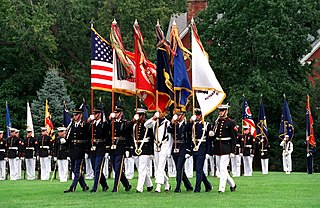
The several branches of the United States Armed Forces are represented by flags. Within the U.S. military, various flags fly on various occasions, and on various ships, bases, camps, and military academies.

The Confederate States Marine Corps (CSMC), also referred to as the Confederate States Marines, was a branch of the Confederate Navy during the American Civil War. It was established by an act of the Provisional Congress of the Confederate States on March 16, 1861. The Corps' manpower was initially authorized at 45 officers and 944 enlisted men, and was increased on September 24, 1862, to 1,026 enlisted men. The organization of the Corps began at Montgomery, Alabama, and was completed at Richmond, Virginia, when the capital of the Confederate States was moved to that location. The headquarters and main training facilities remained in Richmond throughout the war, located at Camp Beall on Drewry's Bluff and at the Gosport Shipyard in Portsmouth, Virginia. The last Marine unit surrendered to the Union army on April 9, 1865, with the Confederacy itself capitulating a month later.
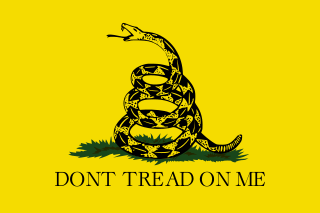
The Continental Marines were the amphibious infantry of the American Colonies during the American Revolutionary War. The Corps was formed by the Continental Congress on November 10, 1775 and was disbanded in 1783. Their mission was multi-purpose, but their most important duty was to serve as onboard security forces, protecting the captain of a ship and his officers. During naval engagements, in addition to manning the cannons along with the crew of the ship, Marine sharpshooters were stationed in the fighting tops of a ship's masts specifically to shoot the opponent's officers, naval gunners, and helmsmen.

The United States Navy Reserve (USNR), known as the United States Naval Reserve from 1915 to 2005, is the Reserve Component (RC) of the United States Navy. Members of the Navy Reserve, called Reservists, are categorized as being in either the Selected Reserve (SELRES), the Training and Administration of the Reserve (TAR), the Individual Ready Reserve (IRR), or the Retired Reserve.
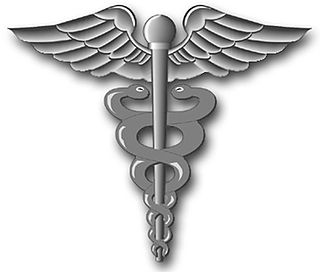
A hospital corpsman is an enlisted medical specialist of the United States Navy, who may also serve in a U.S. Marine Corps unit. The corresponding rating within the United States Coast Guard is health services technician (HS).
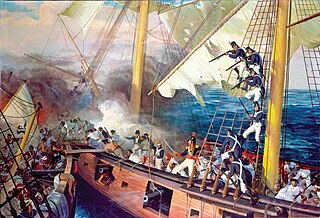
Marines, or naval infantry, are typically a military force trained to operate in littoral zones in support of naval operations. Historically, tasks undertaken by marines have included helping maintain discipline and order aboard the ship, the boarding of vessels during combat or capture of prize ships, and providing manpower for raiding ashore in support of the naval objectives. In most countries, the marines are an integral part of that state's navy.

The history of the United States Marine Corps (USMC) begins with the founding of the Continental Marines on 10 November 1775 to conduct ship-to-ship fighting, provide shipboard security and discipline enforcement, and assist in landing forces. Its mission evolved with changing military doctrine and foreign policy of the United States. Owing to the availability of Marine forces at sea, the United States Marine Corps has served in nearly every conflict in United States history. It attained prominence when its theories and practice of amphibious warfare proved prescient, and ultimately formed a cornerstone of U.S. strategy in the Pacific Theater of World War II. By the early 20th century, the Marine Corps would become one of the dominant theorists and practitioners of amphibious warfare. Its ability to rapidly respond on short notice to expeditionary crises has made and continues to make it an important tool for U.S. foreign policy.
This is a timeline of the Republic of Texas, spanning the time from the Texas Declaration of Independence from Mexico on March 2, 1836, up to the transfer of power to the State of Texas on February 19, 1846.
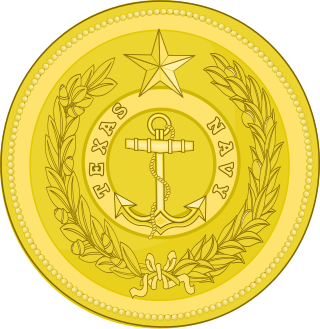
The Texas Navy, officially the Navy of the Republic of Texas, also known as the Second Texas Navy, was the naval warfare branch of the Texas Military Forces during the Republic of Texas. It descended from the Texian Navy, which was established in November 1835 to fight for independence from Centralist Republic of Mexico in the Texas Revolution. The Texas Navy, Texas Army, and Texas Militia were officially established on September 5, 1836 in Article II of the Constitution of the Republic of Texas. The Texas Navy and Texas Army were merged with the United States Armed Forces on February 19, 1846 after the Republic of Texas became the 28th state of the United States.
Naval Hospital Corps School was the United States Navy's only basic hospital corpsman school. It was located within Lake County, Illinois, at 601 D St., Bldg 130H, Naval Station, Great Lakes, Illinois 60088, for nearly a century.
The Texas Military Forces (TXMF) are the principal instrument through which the Texas Military Department (TMD) executes security policy for Texas, which has the second-largest population and border in the United States, and the 9th-largest economy in the world.
The Texas schooner Invincible was one of the four schooners of the Revolutionary Texas Navy (1836-1837). She began her service in January 1836 and immediately began attacking ships supplying the Mexican army in Texas, including capturing the United States merchant vessel Pocket and later the British ship Eliza Russell. Both of these actions caused diplomatic incidents between the Republic of Texas and the United States and the United Kingdom.

The Texan schooner San Antonio was a two-masted schooner of the Second Texas Navy from 1839-1840. She was the sister ship of the San Jacinto and the San Bernard. In 1840, San Antonio was part of the Texas Navy flotilla led by Commodore Edwin Ward Moore which was dispatched to assist Yucatecan rebels that had taken up arms against Mexico. In February 1842, while re-provisioning in New Orleans, the crew of the San Antonio mutinied and the Lieutenant was killed. This was the only mutiny in the history of the Texas Navy. That fall, the San Antonio sailed for Campeche and was never heard from again.

The United States Marine Corps (USMC), also referred to as the United States Marines, is the maritime land force service branch of the United States Armed Forces responsible for conducting expeditionary and amphibious operations through combined arms, implementing its own infantry, artillery, aerial, and special operations forces. The U.S. Marine Corps is one of the eight uniformed services of the United States.

The Texian Army, also known as the Revolutionary Army and Army of the People, was the land warfare branch of the Texian armed forces during the Texas Revolution. It spontaneously formed from the Texian Militia in October 1835 following the Battle of Gonzales. Along with the Texian Navy, it helped the Republic of Texas win independence from the Centralist Republic of Mexico on May 14, 1836 at the Treaties of Velasco. Although the Texas Army was officially established by the Consultation of the Republic of Texas on November 13, 1835, it did not replace the Texian Army until after the Battle of San Jacinto.

The United States Navy (USN) is the maritime service branch of the United States Armed Forces and one of the eight uniformed services of the United States. It is the most powerful navy in the world, with the estimated tonnage of its active battle fleet alone exceeding the next 13 navies combined, including 11 allies or partner nations of the United States as of 2012. It has the highest combined battle fleet tonnage and the world's largest aircraft carrier fleet, with eleven in service, two new carriers under construction, and five other carriers planned. With 336,978 personnel on active duty and 101,583 in the Ready Reserve, the United States Navy is the third largest of the United States military service branches in terms of personnel. It has 290 deployable combat vessels and more than 2,623 operational aircraft as of June 2019.
A ship's company or complement comprises all officers, non-commissioned officers and enlisted personnel aboard a naval vessel, excluding civilians and guests.

The Texian Navy, also known as the Revolutionary Navy and First Texas Navy, was the naval warfare branch of the Texian armed forces during the Texas Revolution. It was established by the Consultation of the Republic of Texas on November 25, 1835. Along with the Texian Army, it helped the Republic of Texas win independence from the Centralist Republic of Mexico on May 14, 1836 at the Treaties of Velasco. It was replaced by the Texas Navy on March 23, 1839.

A Marine Detachment, or MarDet, was a unit of 35 to 85 United States Marines aboard large warships including cruisers, battleships, and aircraft carriers. They were a regular component of a ship's company from the formation of the United States Marine Corps until 1998. Missions of shipboard Marine Detachments evolved, and included protecting the ship's captain, security and defense of the ship, operating the brig, limited action ashore, securing nuclear weapons and ceremonial details. The Marines' successful command structure for dispersed detachments aboard warships encouraged detachments for other purposes.














